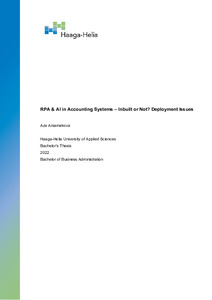RPA & AI in Accounting Systems – Inbuilt or Not? Deployment Issues
Arsamakova, Aza (2022)
Arsamakova, Aza
2022
All rights reserved. This publication is copyrighted. You may download, display and print it for Your own personal use. Commercial use is prohibited.
Julkaisun pysyvä osoite on
https://urn.fi/URN:NBN:fi:amk-202205098138
https://urn.fi/URN:NBN:fi:amk-202205098138
Tiivistelmä
This research-based Bachelor’s thesis discusses the role of robotic process automation (RPA) and artificial intelligence (AI) in accounting systems. The primary objective of the study was to examine the automation solutions of the five most popular accounting software in Finland. The study focused on answering what kind of automation solutions were inbuilt/added on in the five most popular accounting systems and how they were implemented.
The thesis includes a theory part and an empirical part. The theory part discusses accounting information systems and their processes as well as the application of RPA and AI in accounting based on relevant literature and Internet sources. The empirical part focuses on research findings and future development recommendations. The empirical part is divided into two phases: accounting software and webpages analysis, and interviews. The research was based on qualitative methods. First, five accounting software were analyzed by the author using the information from official accounting software webpages. Second, the unstructured interviews were carried out with accounting software representatives to confirm the found information and to obtain views from the software providers’ perspectives. Two out of five accounting software representatives were interviewed. One accounting software representative refused to participate in the interview, the two remaining ones did not reply to interview requests. The results were analyzed using comparative and narrative analysis.
The author’s research using accounting software webpages found that automation solutions (either inbuilt or add-on) were mostly applied in the expenditure cycle of five accounting software. Some accounting software had the requirements for accounting solutions implementation on their webpages, others did not. On the whole, the requirement to start using AI was to maintain accounting accuracy, and the requirement to start using RPA was to learn to apply RPA to record/automate tasks with the help of instructions. The interviews confirmed the information gained from the author’s study and indicated that users of software did not need to have computer programming or any other additional skills to start using automation solutions. They also showed that accounting software companies do not focus on developing both RPA and AI, rather they prefer to concentrate on one of them.
A further recommendation for the commissioning company is to investigate the remaining accounting software included in the research done by financial magazine Tilisanomat. The commissioning company should also concentrate on the price policies of accounting software and ethical issues related to the implementation of AI in accounting software.
The thesis includes a theory part and an empirical part. The theory part discusses accounting information systems and their processes as well as the application of RPA and AI in accounting based on relevant literature and Internet sources. The empirical part focuses on research findings and future development recommendations. The empirical part is divided into two phases: accounting software and webpages analysis, and interviews. The research was based on qualitative methods. First, five accounting software were analyzed by the author using the information from official accounting software webpages. Second, the unstructured interviews were carried out with accounting software representatives to confirm the found information and to obtain views from the software providers’ perspectives. Two out of five accounting software representatives were interviewed. One accounting software representative refused to participate in the interview, the two remaining ones did not reply to interview requests. The results were analyzed using comparative and narrative analysis.
The author’s research using accounting software webpages found that automation solutions (either inbuilt or add-on) were mostly applied in the expenditure cycle of five accounting software. Some accounting software had the requirements for accounting solutions implementation on their webpages, others did not. On the whole, the requirement to start using AI was to maintain accounting accuracy, and the requirement to start using RPA was to learn to apply RPA to record/automate tasks with the help of instructions. The interviews confirmed the information gained from the author’s study and indicated that users of software did not need to have computer programming or any other additional skills to start using automation solutions. They also showed that accounting software companies do not focus on developing both RPA and AI, rather they prefer to concentrate on one of them.
A further recommendation for the commissioning company is to investigate the remaining accounting software included in the research done by financial magazine Tilisanomat. The commissioning company should also concentrate on the price policies of accounting software and ethical issues related to the implementation of AI in accounting software.
